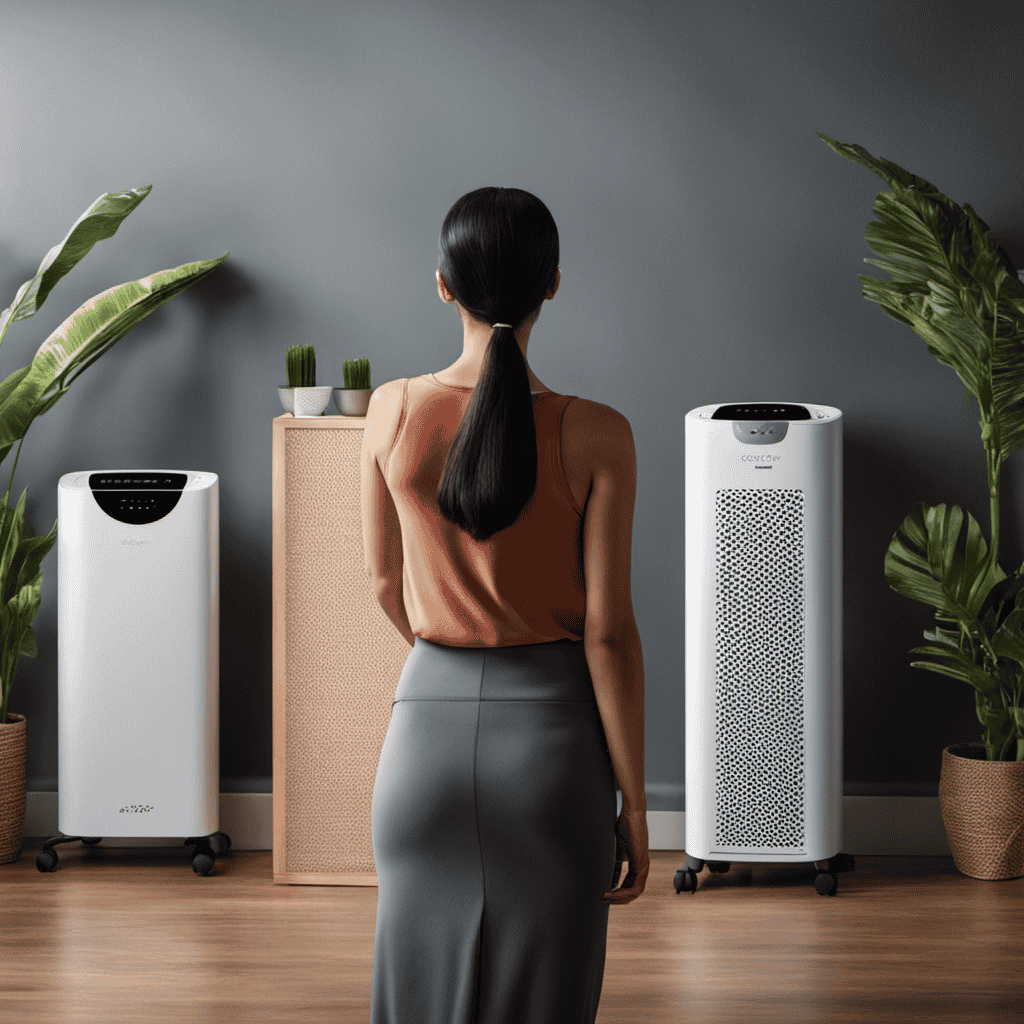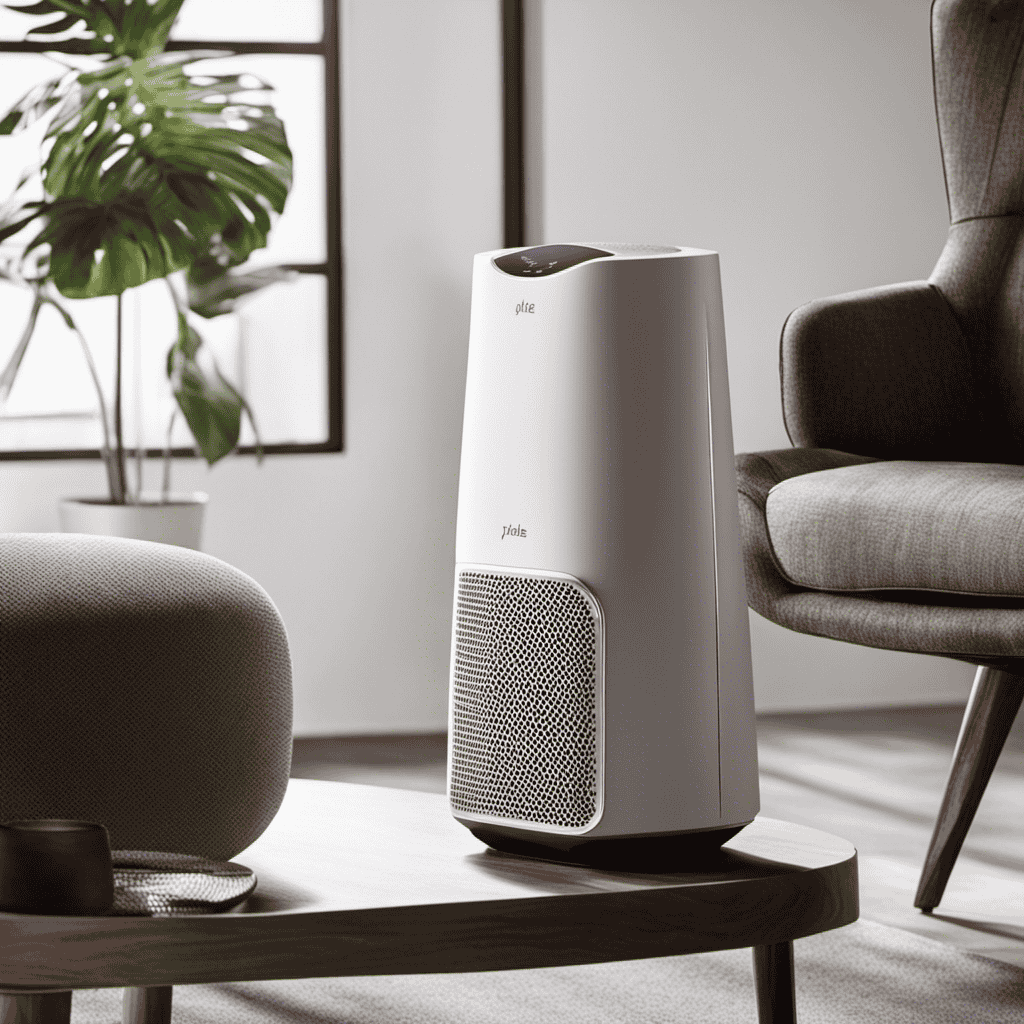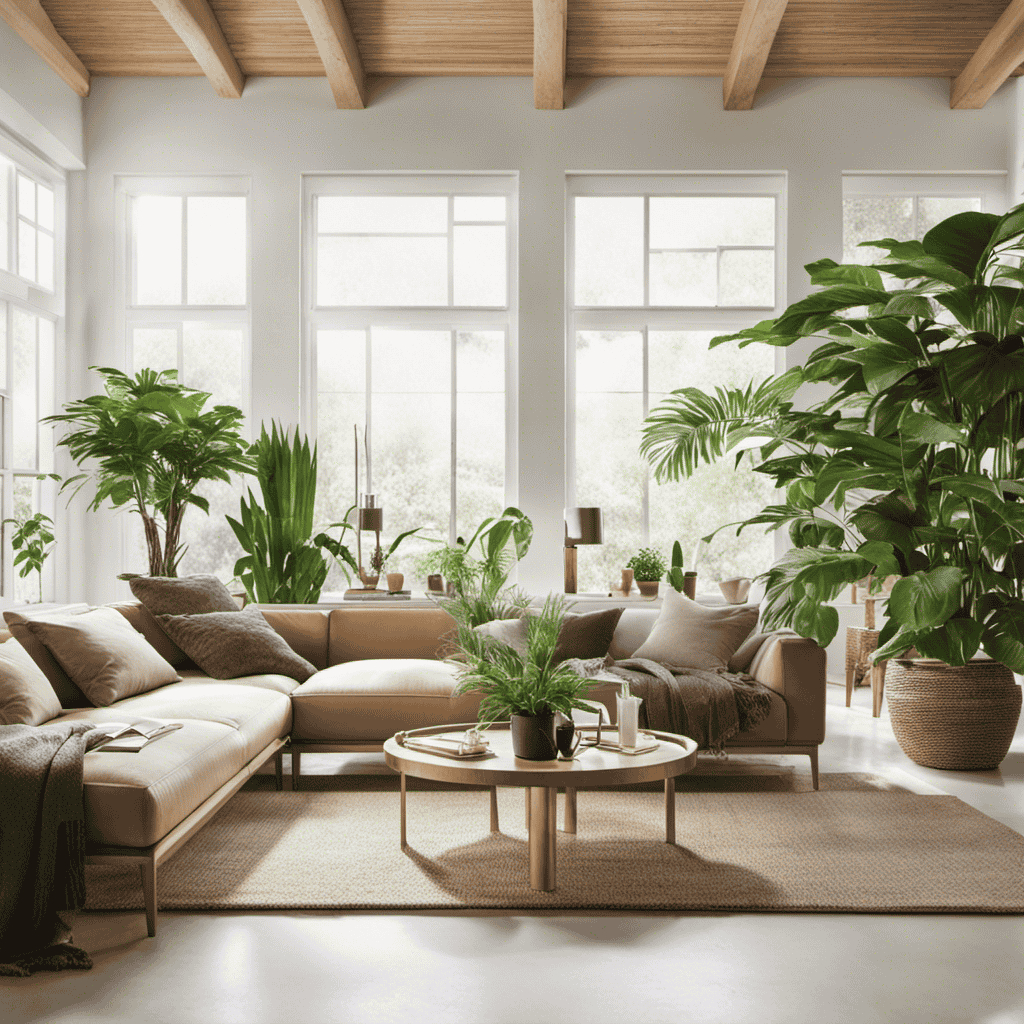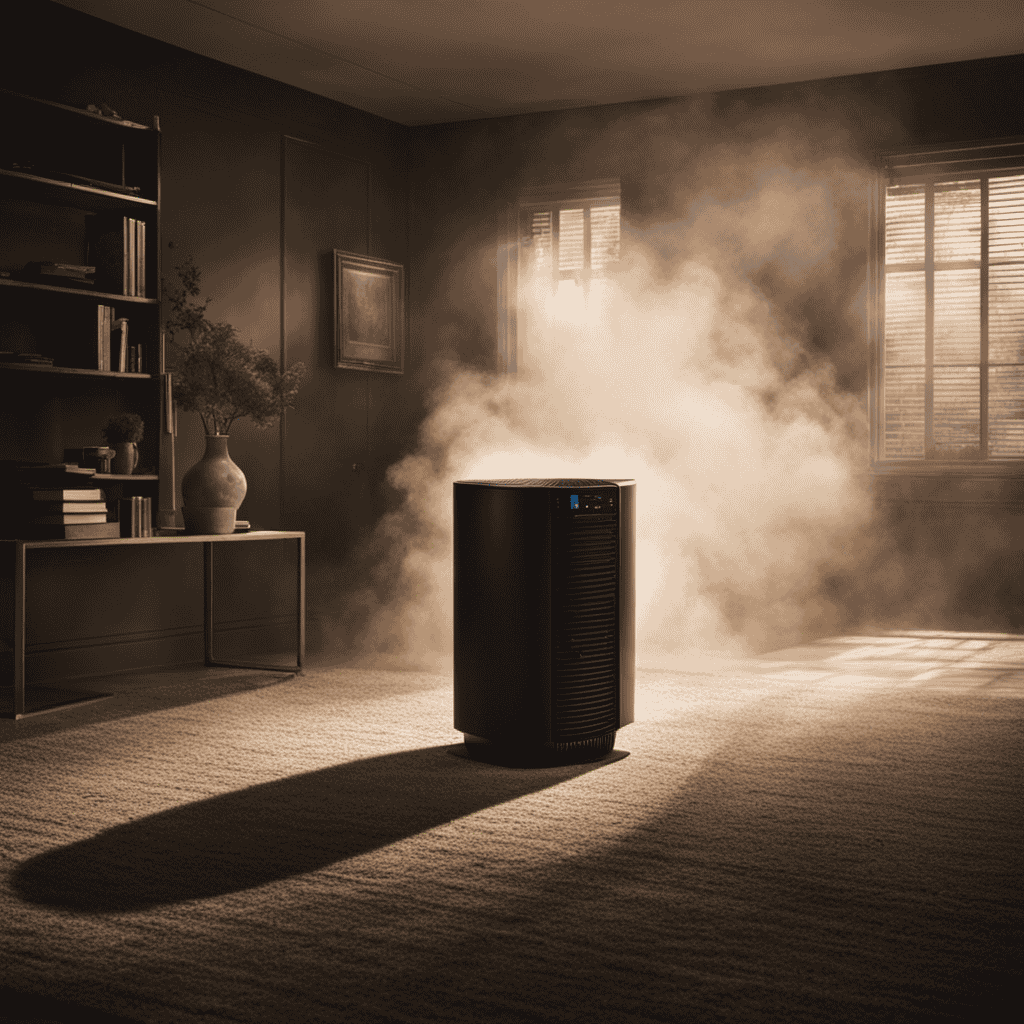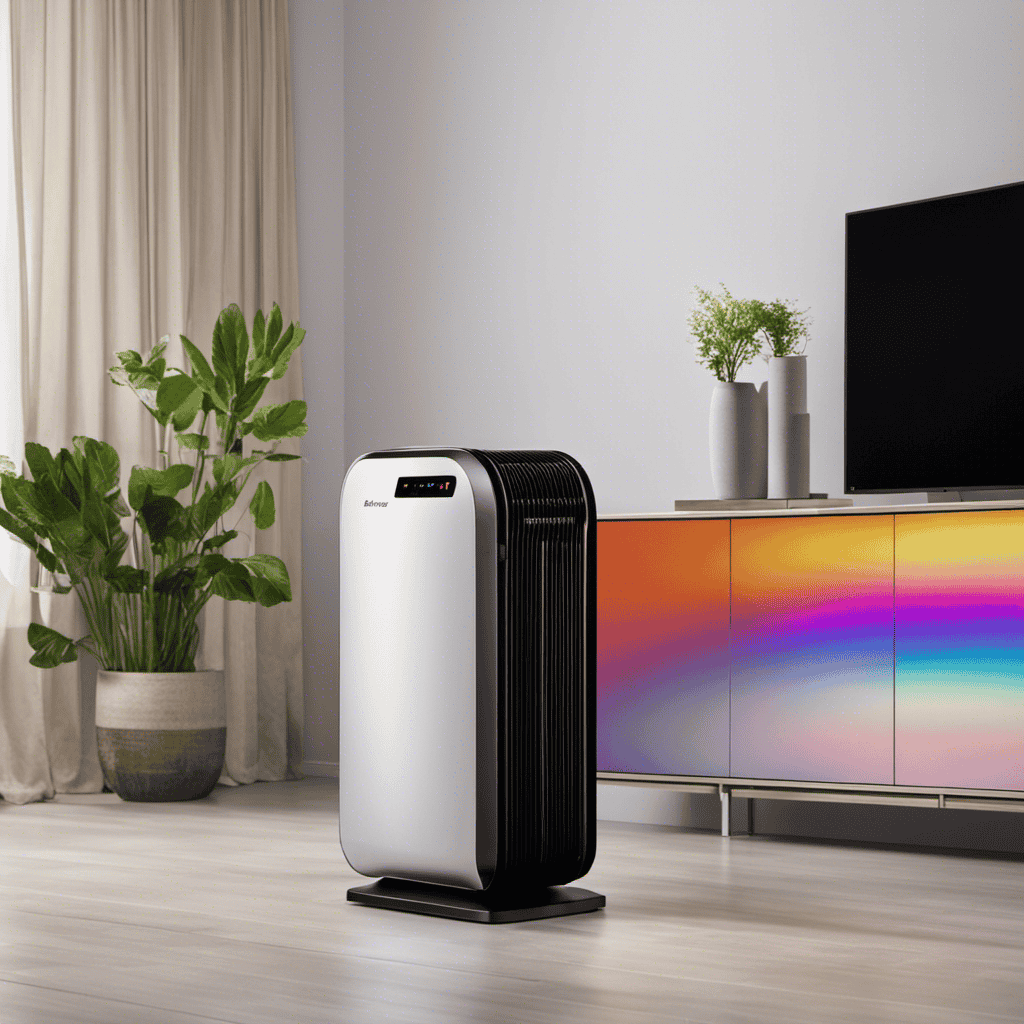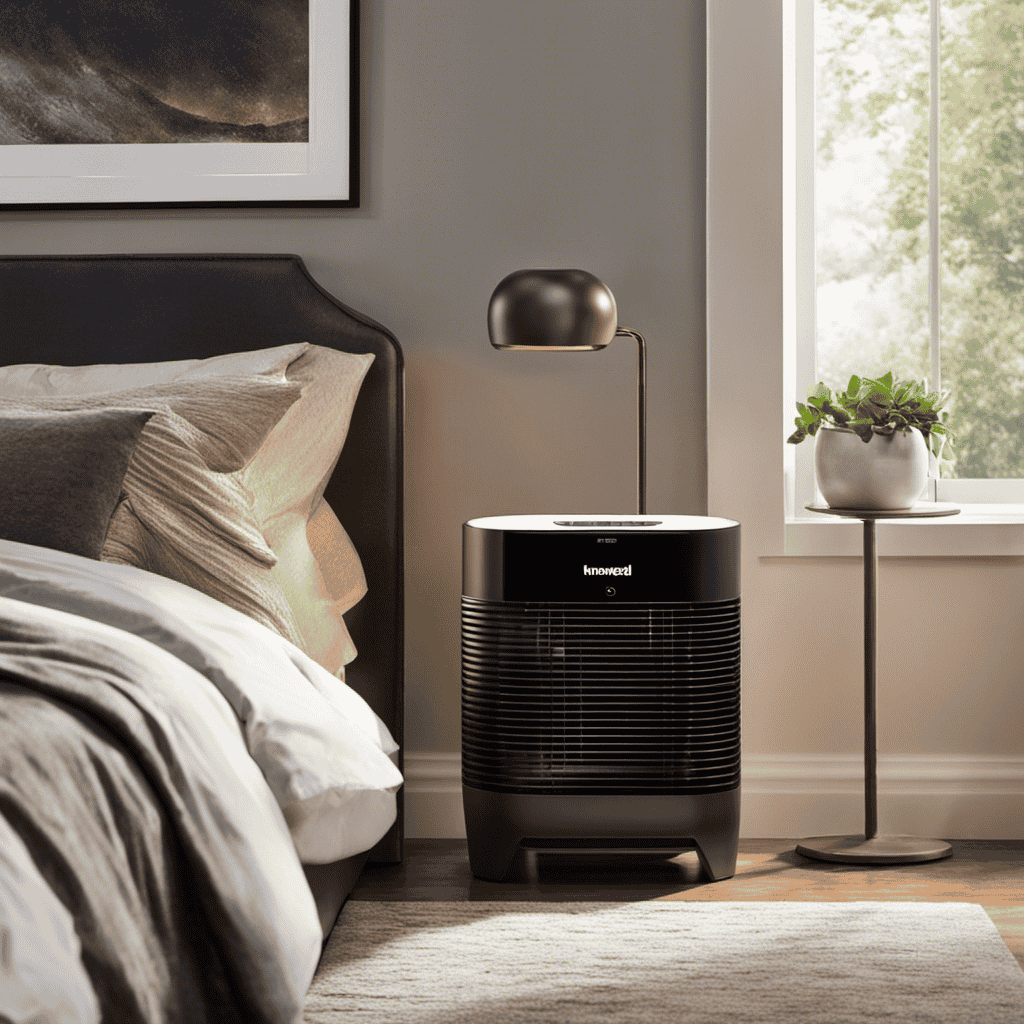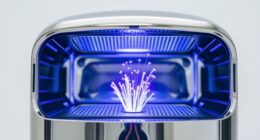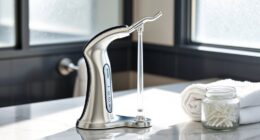Indoor air can be up to 5 times more polluted than outdoor air. That’s why it’s important to consider buying an air purifier.
In this article, I will guide you through everything you need to know before buying one. From the different types of air purifiers available to the key features you should consider, we will explore the coverage area, noise levels, filter types, and more.
Stay tuned for valuable insights to make an informed decision.
Key Takeaways
- Consider the room size and match it with the coverage area of the air purifier for optimal air purification.
- Look for air purifiers with customizable fan speed options and silent operation for a comfortable environment.
- Understand the different filter technologies (HEPA, activated carbon, ionizers) and their pros and cons for effective removal of pollutants.
- Evaluate the cost and budget considerations, including long-term maintenance costs and filter replacement expenses, to ensure value for money.
Types of Air Purifiers
Now let’s talk about the different types of air purifiers you should consider.
When it comes to air purifiers, there are various brands and size options available in the market. Different brands offer different features and technologies to cater to individual needs. Some popular air purifier brands include Dyson, Honeywell, and Blueair. These brands are known for their quality and effectiveness in purifying the air.
In terms of size options, air purifiers come in various sizes to accommodate different room sizes. You can find compact air purifiers suitable for small rooms and larger units designed for bigger spaces. It is important to consider the size of the room where you plan to use the air purifier to ensure optimal air purification.
Key Features to Consider
When looking for an air purifier, you should consider key features. Two important aspects to focus on are cost-effective options and brand reputation.
Cost-effective options are vital because air purifiers can be a significant investment. It is essential to find a model that not only fits within your budget but also provides long-term value. Look for air purifiers that have energy-efficient settings and low maintenance requirements to save on operational costs.
Additionally, it is crucial to consider brand reputation. Look for well-established and reputable brands that have a history of producing high-quality air purifiers. Brands with a positive reputation are more likely to provide reliable products that effectively clean the air in your home.
Coverage Area and Room Size
It’s important to consider the coverage area and room size when choosing an air purifier. The size of the room will determine the effectiveness of the purifier in cleaning the air. Here are some key points to consider:
- Calculate the room size by multiplying the length and width of the room. This will give you an idea of the square footage that the air purifier needs to cover.
- Choose an air purifier with a coverage area that matches or exceeds the calculated room size. This ensures that the purifier can effectively clean the air in the entire room.
- Optimal placement of the air purifier is important for maximum efficiency. Place it in a central location in the room, away from obstructions, and ensure that it has proper airflow.
- Consider the height of the room as well. If the room has high ceilings, choose an air purifier with a higher Clean Air Delivery Rate (CADR) to ensure efficient air purification.
Considering the coverage area and room size will help you select an air purifier that effectively cleans the air in your space.
Now let’s move on to the next important factor: noise level and fan speed options.
Noise Level and Fan Speed Options
To ensure a comfortable environment, it’s important to consider the noise level and available fan speed options when selecting an air purifier.
When it comes to noise level, choose an air purifier that operates silently. This is particularly important if you plan on using the air purifier in your bedroom or any other area where you require a quiet environment. Look for models that specifically mention ‘silent operation‘ or ‘quiet operation’ in their product descriptions.
In addition to noise level, customizable fan speed options are also a key consideration. Having the ability to adjust the fan speed allows you to tailor the air purifier’s performance to your specific needs. For example, you may want a higher fan speed during the day when there’s more activity in the room, and a lower fan speed at night when you’re sleeping. Look for air purifiers that offer multiple fan speed settings, so you can easily customize the air purification process according to your preferences.
Filter Types and Replacement Frequency
When considering an air purifier, it’s important to understand the lifespan and cost of the filters as well as the different filter technologies available.
The lifespan of a filter can vary depending on the model and usage, so it’s crucial to know how often the filters need to be replaced and the associated cost.
Additionally, understanding the different filter technologies such as HEPA, activated carbon, and ionizers can help determine which type is best suited for specific air purification needs.
Filter Lifespan and Cost
You’ll need to consider the filter lifespan and cost when choosing an air purifier. The filter lifespan refers to how long the filter will effectively remove pollutants from the air before it needs to be replaced. The cost of the filter includes both the initial purchase price and the cost of replacement filters over time.
Here are some key points to keep in mind:
-
Filter lifespan: Different air purifiers have different filter lifespans, ranging from a few months to a few years. Consider how frequently you’ll need to replace the filter and factor that into the overall cost.
-
Filter replacement frequency and schedule: Some manufacturers provide recommendations on how often to replace the filters. It’s important to follow these guidelines to ensure the continued effectiveness of the air purifier.
-
Cost: When comparing air purifiers, consider not only the upfront cost but also the long-term cost of replacing filters. Some filters may be more expensive, but if they last longer, they may be more cost-effective in the long run.
-
Effectiveness: A longer filter lifespan doesn’t necessarily mean better air purification. Consider the effectiveness of the filter in removing pollutants and choose an air purifier that suits your needs and budget.
Different Filter Technologies
The lifespan and cost of filters vary depending on the different technologies used. When choosing an air purifier, it is important to understand the pros and cons of different filter technologies to ensure you select the right one for your needs. To help you make an informed decision, here is a table comparing three common filter technologies: HEPA, activated carbon, and ionizers.
| Filter Technology | Pros | Cons |
|---|---|---|
| HEPA | Highly effective at removing airborne particles such as dust, pollen, and pet dander. | May need frequent filter replacements and can be costly. |
| Activated Carbon | Excellent at removing odors and chemicals from the air. | Less effective at capturing larger particles and may have a shorter lifespan. |
| Ionizers | Can effectively remove ultrafine particles and can be used without filter replacements. | May produce ozone as a byproduct, which can be harmful to health in high concentrations. |
Consider your specific needs, such as allergies or odor control, when choosing the right filter technology for your air purifier.
Energy Efficiency and Power Consumption
To save on electricity costs, make sure to check the energy efficiency rating and power consumption of the air purifier you’re considering. This is important not only for your wallet but also for the environment.
Here are some key things to consider when it comes to energy efficiency and power consumption:
-
Look for air purifiers with power saving features such as adjustable fan speeds or timers. These features allow you to customize the level of filtration needed and reduce energy usage.
-
Check the energy efficiency rating of the air purifier. Look for models that are ENERGY STAR certified, as they meet strict criteria for energy efficiency.
-
Consider the power consumption of the air purifier. Look for models with lower wattage, as they consume less electricity.
-
Be mindful of the environmental impact. Choose air purifiers that use eco-friendly materials and have minimal ozone emissions.
Air Quality Sensors and Indicators
Consider investing in an air purifier that has built-in air quality sensors and indicators. These sensors are designed to detect various pollutants and contaminants in the air, such as dust, allergens, smoke, and volatile organic compounds (VOCs). With the help of these sensors, the purifier can adjust its settings accordingly to effectively remove these harmful particles from the air.
Additionally, the indicators on the device provide visual feedback on the current air quality. This allows you to monitor the effectiveness of the purifier and take necessary actions.
Regular air purifier maintenance is essential to ensure optimal performance and prolong the lifespan of the device. This may include cleaning or replacing filters, checking the sensors, and regularly cleaning the air vents.
Additional Purification Technologies
In my previous subtopic, I discussed the importance of air quality sensors and indicators in air purifiers. Now, let’s delve into additional purification technologies that can enhance the effectiveness of these devices.
When comparing different purification technologies, it’s essential to consider their ability to remove various pollutants from the air. Here are some common technologies used in air purifiers:
-
High-efficiency particulate air (HEPA) filters: These filters trap particles as small as 0.3 microns, including dust, pollen, and pet dander.
-
Activated carbon filters: These filters are effective in removing odors, gases, and volatile organic compounds (VOCs) from the air.
-
Ultraviolet (UV) germicidal irradiation: UV light can kill bacteria, viruses, and mold spores, providing an additional layer of protection against airborne pathogens.
-
Electrostatic precipitators: These devices use an electrostatic charge to attract and capture particles, such as smoke and allergens.
Maintenance and Cleaning Requirements
When comparing different purification technologies, it’s important to understand the maintenance and cleaning requirements of each option. Proper maintenance and regular cleaning are crucial for the efficient functioning of an air purifier.
Different cleaning techniques may be required depending on the type of technology used. For example, if you have a mechanical filter, such as a HEPA filter, it will need to be replaced periodically. Electronic air purifiers may require cleaning of the collector plates or wires to remove accumulated particles. UV-C light purifiers may need occasional cleaning of the bulbs to ensure optimal performance.
Necessary tools for cleaning an air purifier may include a vacuum cleaner, soft brush or cloth, and mild cleaning solution. Following the manufacturer’s instructions is essential to ensure proper maintenance and longevity of your air purifier.
Cost and Budget Considerations
When considering the purchase of an air purifier, it’s important to carefully evaluate the price versus the performance of the device.
While a lower-priced air purifier may seem like a good deal initially, it is crucial to assess its effectiveness in improving indoor air quality.
Additionally, long-term maintenance costs should be taken into account in order to determine the overall value for money of the chosen air purifier.
Price Vs. Performance
To get the most bang for your buck, you’ll want to consider the price versus performance when choosing an air purifier. When comparing prices, keep in mind that higher-priced models may come with additional features or advanced filtration systems. However, it’s important to evaluate the performance of the air purifier as well.
Here are some key factors to consider in your price comparison and performance evaluation:
-
Clean Air Delivery Rate (CADR): Look for a high CADR rating, as it indicates the purifier’s efficiency in removing pollutants from the air.
-
Filter Replacement Costs: Consider the cost and frequency of replacing filters, as this can impact the long-term expenses of owning an air purifier.
-
Coverage Area: Ensure that the purifier’s coverage area matches the size of the room where you plan to use it.
-
Energy Efficiency: Look for an energy-efficient model to minimize electricity costs over time.
Long-Term Maintenance Costs
To minimize your long-term expenses, it’s important to factor in the cost and frequency of replacing filters when considering an air purifier.
Filter maintenance is a crucial aspect of owning an air purifier, as it ensures that the device functions effectively and efficiently. Regularly replacing the filters helps to maintain clean and healthy indoor air quality.
However, it’s essential to consider the filter replacement costs as they can vary depending on the brand and model of the air purifier. Some filters can be expensive, and if they need to be replaced frequently, it can significantly impact your overall maintenance expenses.
Therefore, it’s advisable to research and compare the filter replacement costs before making a purchase to ensure it aligns with your budget and long-term maintenance plans.
Value for Money
Considering the filter replacement costs is essential in determining the value for money when purchasing an air purifier. Here are some key factors to consider:
-
Air purifier brands: Research different brands and compare their filter replacement costs. Some brands may offer more affordable replacement filters, while others may be more expensive.
-
Warranty options: Look for air purifiers that come with a warranty. This can provide added value and peace of mind, as it may cover the cost of filter replacements during the warranty period.
Taking these factors into account can help you make an informed decision and ensure that you are getting the best value for your money when purchasing an air purifier.
Now, let’s explore another important aspect of choosing an air purifier: user reviews and ratings.
User Reviews and Ratings
User reviews and ratings can provide valuable insights when researching air purifiers. As a consumer, I rely heavily on these reviews to make informed decisions about which product to purchase. Reading about other users’ experiences gives me a sense of the product’s performance and its ability to meet my specific needs.
I pay close attention to the overall rating of the air purifier and the specific feedback provided by users. This helps me gauge the effectiveness of the purifier in removing allergens, dust, and other pollutants from the air.
Additionally, user reviews often include helpful product recommendations based on personal experiences. I find this information extremely valuable in narrowing down my options and choosing the best air purifier for my home.
Is It Necessary to Replace Air Purifiers, or Can They Be Repaired?
When considering disposing old air purifier, it’s important to weigh the cost of repairs versus replacement. In some cases, simple fixes can extend the life of your purifier. But if it’s outdated or the repair costs outweigh a new one, it may be best to replace it for better air quality.
Conclusion
In conclusion, after diving into the world of air purifiers, I must say, it’s like discovering a hidden treasure for your indoor air quality.
These machines are like superheroes fighting against the invisible enemies that lurk in the air.
With their various types, features, and technologies, they have the power to transform your space into a clean and refreshing oasis.
So, if you want to breathe in the purest air imaginable, don’t hesitate!
Get yourself an air purifier and experience the wonders it can do for you and your loved ones.
